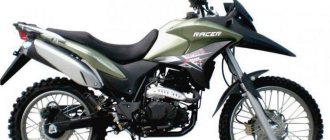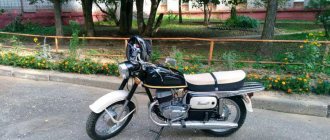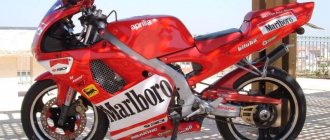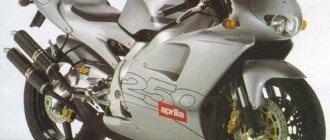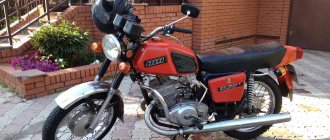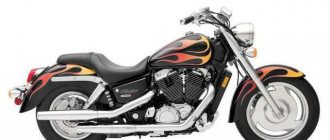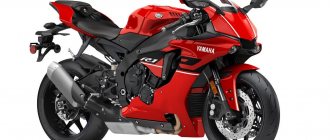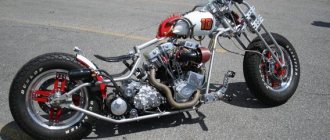The F800 GS motorcycle was first presented at the EICMA exhibition in Milan in November 2007. Sales of this model from BMW began in early 2008. The BMW F800 GS is a version of the F650GS, which was produced from 2008 to 2012, but differs from it in its greater off-road focus and more expensive equipment. The BMW F800 GS copes excellently with deep fords, sand dunes, and even mountain passes. For him, moving on any type of road is not a problem. This BMW model is the ideal vehicle for long journeys. It is equipped with a powerful frame and features large suspension travel. Already in the standard version, the F800 GS is equipped with ABS and has 2 driving modes. Optionally, you can select 1 of 4 driving modes. Comfort of movement on any surface is guaranteed by the directional stability system. By the way, when riding off-road, ABS on the F800 GS motorcycle can be turned off. A large number of original accessories and special equipment from BMW motorcycles allows you to adapt the F800 GS to your own requirements and preferences. All of them have characteristics such as functionality, practicality and impeccable appearance. With accessories you can always emphasize the expressiveness of BMW style. The main unit of the motorcycle is a fuel-injected in-line 2-cylinder Rotax engine. It has a power of 85 horsepower, a torque of 83 Nm and a displacement of 798 cc. cm. The performance of such a BMW motorcycle engine is 5.5-7.5 thousand revolutions per minute. Features of the F800 GS include: • steel frame; • adjustable suspension; • monoshock absorber; • single-disc rear and double-disc front brakes; • spoked wheels with a diameter of 17 and 21 cm; • 16 liter fuel tank. Immediately after its release, this model was highly appreciated by experts. In 2009, the F800 GS received the title of “Motorcycle of the Year”. It has often been compared to the legendary Honda Africa Twin. This model was also compared with the R1200GS. Experts appreciated the greater accessibility and lighter weight of the vehicle. Fans of the brand and positive reviews from experts did their job. For more than 10 years, approximately 10,000 products have been sold per year. This model from BMW is available in two color schemes: • Rallye – the white-black-red version emphasizes not only its confident character, but also the incomparable abilities demonstrated when moving off-road; • Racing Blue metallic – in this color scheme, combining metallic, blue and black, the BMW model looks as stylish and dynamic as possible, allowing it to highlight the individuality of its owner.
Main modifications
F800 GS is available in the following versions: • standard F800 GS; • luxury F800 GS Adventure. The luxury version of the model from BMW has been available since 2013. It differs from the standard one: • in the shape of the windshield; • fuel tank with increased volume (24 liters versus 16); • engine protection; • a seat with a modified shape; • hand protection; • built-in fastenings for cases; • traction control system; • electronically adjustable suspensions. Throughout its history, this model from BMW was modernized only in 2013. The update was cosmetic. The F800 GS model received a new form of plastic, a different radiator grille and several other innovations. All of them were immediately noted by both potential buyers and experts.
The smallest “goose” BMW G310GS: formed opinion after 8 months of operation
Translation of an article by John Milbank, editor of Bennetts BikeSocial, member of the International Association of Automobile Theft Investigators and the Motorcycle Crime Reduction Group.
The author of the material has more than 20 years of driving experience
Mileage cutoffs for two mopeds in this review: 3680 km and 2225 km
Brief parameters of the device in question
Power: 34 hp Torque: 28 Nm Weight: 169.5 kg. Price: 5,100 pounds sterling (about 535,000 rubles)
The BMW G310GS is constantly criticized. Firstly, the motorcycle was made in India (this is true; it turns out that this fact is really upsetting to some). Secondly, many riders report strong vibration (probably because I always ride alone - I didn’t notice this). Thirdly, it is often called too slow (it gets along well on UK country roads and motorways). And finally, they say that the 310 “caterpillar” is not worthy of bearing the “GS” (Gelände/Straße - off-road/road) index in its name, which BMW has worn since the release of the R80 G/S in the distant 1980s.
Is the BMW G 310 GS GS name ?
I sincerely believe that yes. I wouldn’t call myself an experienced off-road rider, but sometimes I like to go off-road. I recently sold my KTM 1050 Adventure - the bike itself is great, but the off-road features seemed useless to me: it was too heavy.
I can say the same for the mighty R1200GS/R1250GS goose - even though I've learned how to handle it effectively on pavement, I know that if I slip or drop the bike off-road, it'll be up to me to lift its 249 kilograms of weight. It won’t be easy, and repairs will cost you money.
The G310GS has a curb weight of just 169.5kg, so returning it to an upright position is a breeze. And, as I know from experience, a fall will not cause serious damage.
I will give the opinion of John Mitchinson, owner of Rally Raid Products in Northamptonshire. Despite his status as an experienced enduro rider, he likes the baby GS for its light weight. But John also understands that the motorcycle can and should be improved, so his company produces upgraded suspension, spoked wheels and other useful accessories for the GS.
Experienced off-road riders will notice that the G310GS's soft, relatively bouncy suspension isn't up to par - and that's a valid point. But ask a simple person like me, who enjoys riding on rural roads, and I will answer that she is fine. Although, in fairness, it is worth noting that I tried a modified version of Rally Raid - and the difference was significant. But I like the idea of going the full bike owner route - enjoying the bike as is until you reach the limits of the suspension. When (or if) this happens, you can start thinking about Rally Raid upgrades and you'll have a superbly tuned bike.
Is the BMW G 310 GS an adventure motorcycle?
Of course, yes—unless you associate the word “adventure” with driving long distances across several countries on highways.
My idea of off-road riding is simple: take half a day on the weekend to explore new trails and country roads, or take a short trip along the back roads through France to Spain. “Gosling” copes with both options perfectly.
For other riders, “adventure” may mean exploring the depths of eastern countries, overcoming difficult trails and spending the night in a tent. In this case, they will have to carry with them everything they need for such a trip for several months. Honestly, this is beyond my capabilities for the foreseeable future. And although the G310GS is quite suitable for this, motorcycles with a larger cubic capacity are more suitable for such purposes. Having bought a Royal Enfield Himalayan around the world, Nathan Millward is proud of his bike - not least because of its ability to carry a lot of luggage: he can literally strap bags around it, not to mention the fact that it comes with panniers.
The Mini GS is designed to only use the top case and nothing more, but that suited me just fine; I installed a Givi luggage rack on it and with my overloaded 52 liter Trekker pannier I had no problems when taxiing. Exactly the same as with the Moto Fizz Camping bag, strapped to the tail instead of the central case, even with the latter weighing 29 kg. The little gosling coped with all his tasks perfectly.
the BMW G 310 GS perform as a daily bike?
Its light weight and excellent maneuverability make it indispensable in the city - you can easily avoid traffic jams. I installed a Givi luggage rack, as well as Barkbusters hand guards (for extra protection as well as wind protection) and R&G crash bars.
There is enough space under the seat to attach straps for additional luggage and accommodate a wheel lock. Although I did not install any additional electronic accessories (except for the TomTom Rider navigator), the generator is quite capable of powering them.
To make sure of this, I connected Oxford heated grips (about 3 amps), Keis heated jacket (5.4 amps) and Keis heated pants (2.9 amps); At idle with a full additional load of 11.3 amps, the battery voltage dropped from 14.6 to 13.6 volts. A little more revolutions - and it rose again to 14.3 volts. When the heated steering grips were turned off, the generator, even at idle, supplied 14.4 volts to the battery: accordingly, when all accessories are turned on at the same time, the “caterpillar” will be able to maintain the level necessary for the battery to be fully charged while driving.
Is the engine power of the G 310 GS ?
It all depends on what you are going to do with it. Commuting to work every day, driving along country roads and accelerating on British motorways at up to 130 kilometers per hour - it copes with this with a bang; but take a passenger plus luggage and you'll want a more powerful motorcycle.
The specific engine power is 0.2 hp/kg; for comparison, the power of the R1250GS is 0.5 hp/kg. Conclusion: you need power - prepare your money. If you're interested in a car comparison, the BMW 318i Sedan produces 0.09 hp/kg. The 3.0-liter M3 is about the same as the G310GS. But there's certainly something to brag about here - the M3 also produces 0.4 Nm per kilogram, compared to the 310's 0.1 Nm (the R1250GS produces 0.5 Nm per kilogram).
G 310 GS engine really vibrate?
Several journalists (whom I have great respect for) have said that the BMW has a vibrating engine, but I disagree - of course you feel the vibration, but it is a single-cylinder! This never caused me any discomfort, and even with the rubber footpeg spacers removed, I didn't feel any vibration through them or through the handlebars or seat when riding off-road.
However, the vibration is really noticeable in the mirrors, and while objects behind are easy to see, details are harder to discern (for example, the word "police"). The motorcycle “growls” is also not so beautiful, with asthmatic sighs (the sound is much better with the Scorpion muffler from Rally Raid).
The plastic of the body, although durable and well-made (it was the work on it that led to the delay in the launch of the motorcycle for sale), rattles at times; It definitely doesn't help the budget (for BMW) image.
Worst of all, the clutch makes an unpleasant clunking sound when shifting at high revs, like when you've finally pulled out of weaving between cars in traffic. Adam Mitchinson, who finished the Australian APC Rally this year in "three hundred and tenth", noted that over time the sound disappeared. My bike has only traveled 2225 km, and the previous one - almost 3700 km, but the noise on both bikes remains.
Does the G 310 GS problems or malfunctions?
So, why did I end up with two identical tracks, and also - what makes maintaining the motorcycle much more difficult?
Last June, I rolled the gosling out of the garage with the intention of servicing it. I left the bike on the kickstand and went back to the garage to get my tools. Hearing a crash, I found the motorcycle lying on the ground: the bracket holding the side stand had broken in half, causing the bike to fall on its side.
My kickstand gave in a few days before the recall was announced...
Since the bracket is part of the frame, everything will have to be completely disassembled.
The problem was recently discovered and repairs will take time. A reinforcing element that can be installed on motorcycles that were manufactured before the manufacturer changed the frame design has already been developed, but many customers are faced with the need to completely replace the frame due to signs of premature corrosion and destruction (this is where Indian “quality” comes from). I was lucky that my BMW dealer had a second bike in stock, which they provided as a replacement for the first without question.
At first, the manufacturer justified itself by claiming that the root of the problem was that people stood on the motorcycle pegs with all their weight when the pegs were extended - but I didn’t do that. And, to be honest, I expected that any bike (especially the adventure class) should withstand this.
If a crack occurs or the bracket breaks off completely, like mine did, a new frame will be needed.
There were also comments on thematic forums of owners about problems with the water pump seal and starter. But they passed me by. I was faced with a leaking output shaft seal - the first sign was a drop of oil hanging on the sight glass, and I soon tracked it down to the front sprocket. The leak is not critical, but the seal needs to be replaced - Balderston BMW in Peterborough assures me that this is a relatively simple job, and, again, they will provide me with another bike while the repair is carried out.
The headlight is quite annoying; not me myself - the light is quite bright and has a good spread - but the drivers of oncoming cars. The headlight vibrates violently, bouncing up and down. When switching to high beam, problems also arise for the rider - the foreground is darker than the illuminated part far ahead. This is where an extra light (like the Denalis I've used on other bikes) can help.
On the second “caterpillar”, after driving off-road, play in the steering column appeared. To solve the problem, you need to remove the top clamp and handlebar, and then tighten the bolt and nut. The guys at Rally Raid say this is common on showroom bikes. Once the bolt was tightened the problem did not reoccur.
Is it worth buying a BMW G 310 GS ?
I'm often asked: would I buy the motorcycle I'm testing now with my own money? Usually an honest answer outweighs all other details and opinions. Test driving a motorcycle means understanding your target audience and sharing what you think is important, as well as pointing out any shortcomings.
Even though I had already purchased a KTM 1050 Adventure, within the first few months of riding the GS, I was really wondering if it would be suitable as a second bike allowing me to explore more off-road terrain. But as time passed, I found that the bike lacked performance for my taste - not because I really needed more, but simply for the thrill of it. I also have a Honda MSX125 that I've modified for light off-road riding (my Africa Grom), so I can satisfy my desires.
To be honest, the listed shortcomings of the “caterpillar” personally put me off buying it. But each manufacturer has pros and cons, so I will supplement my opinion with reviews from two other owners.
Reviews from BMW G 310 GS
Kevin Fairbairn has been driving for 14 years and purchased the G310GS in early March 2018.
“My first bike was a Honda CB500 which I paid £400 for - I completely rebuilt it from scratch but was so disappointed by the trip to the service station that I sold it the next day! Next up was a 1999 Kawasaki ZX9-R, but in new condition. As an inexperienced rider, he scared the daylights out of me most of the time, but he was my baby. I later sold it and foolishly bought a 2004 Kawasaki Z750 because my then-girlfriend started riding with me as a passenger and I wanted something more reasonable. This is the worst motorcycle I've ever owned."
“I only drove the Z750 for a month, then bought a 1996 BMW R1100R, which I partially restored myself and drove for several years; great bike. That's when my passion for motorcycles got out of control."
“I owned four bikes at the same time: a BMW C1 (I rode one for 12 months), a BMW R1100R, a GSX-R600 Alstare, a Tomos A3 (yes, they still exist) and a Puch Maxi. Then I got my act together and got rid of the scrap metal to concentrate on one decent bike, so in 2015 I bought a new BMW R NineT. I was delighted with this bike, but foolishly sold it at the end of the season. Missing it, I picked up another one in 2021, but this time the all-aluminum Sport version. I sold it again at the end of 2016, wanting more comfort, and bought a BMW R1200R Sport - another world! This happened at the end of 2021, which brings me to the G310GS. Along with all these bikes I've dabbled in a few classic BMWs (R65 and R100GS, but haven't really ridden them much, and a couple of TTR250s - Raid and Open Enduro). Looking back, I realize that there were too many motorcycles.”
Why did you buy a BMW G 310 GS ?
A friend suggested remembering his youth and bought a “gosling” for himself. I haven't ridden it, but I thought a small motorcycle might be fun and maybe encourage me to slow down on my daily commute. Powerful motorcycles constantly goad and provoke you, and some days I felt like I was pushing myself to an early grave!
The decision was also influenced by the money issue. I bought this bike on a great deal so I'm paying less than £65 a month for it.
How do you use it?
It's a great everyday option, offering excellent fuel economy and small enough to weave through rush hour traffic. I average about 40 kilometers a day and am thinking of trying it out on country roads.
I have a bag attached to the trunk and a backpack that holds my work clothes and a packed lunch.
Have you changed anything on the motorcycle, or would you like to change it?
The first thing I did was change the turn signals to LED ones - they shine much brighter and generally look better. I then installed a taller windshield from Powerbronze, as well as hand guards to help keep out the cold wind as well.
I also installed an additional light, tracker and R&G radiator guard to protect the radiator from damage from rocks from the tires of cars in front.
What do you like most about a motorcycle?
It's like driving a 125cc when you're 17 and trying to squeeze every last 34 horsepower out of a little crawler. Big bike mode aside, this is actually a lot of fun!
What is the main disadvantage?
No heated grips or center stand. Both are supposed to be delivered soon, but are still delayed - and it's damn cold at this time of year!
How much does it cost to maintain and maintain a motorcycle?
In everyday use, it consumes about 3.2 liters of gasoline per 100 km, so it is now almost self-sustaining. I also save about 15 minutes of time on each one-way trip compared to driving. Service is done every 9600 kilometers or once a year, I don't think it will be expensive and I'll probably trade it in before any major repairs are needed.
At the beginning of the year I slipped at low speed and put my bike on its side. There was damage, but mainly on one side. New plastic, grips and muffler repair - and the motorcycle is back on the road. The parts were surprisingly cheap - my gear was more expensive, but it did the job and proved the importance of proper protection! Yes, and I have since installed crash bars.
What problems have you encountered?
I contacted service because of a problem with the side step. When I first heard about this problem, I assumed that someone had clearly overloaded the bike. But when the service center looked at the modification of the footrest, it turned out that I needed a new frame under warranty due to a microcrack. But that hasn't put me off - it's still a great bike that's becoming a closer friend to me every day.
How long do you plan to ride it, and what bike will be next?
I usually change bikes regularly, but because of the low monthly payments, I may just keep it for everyday riding for the next three years and buy something else for longer trips. I still miss the big “goose”!
Roger Bikerstaff, 44 years of driving experience, purchased a G 310 GS in April 2021.
I've owned a variety of motorcycles before - Suzuki, Norton, Triumph, MZ, Honda, BSA, Yamaha and BMW. I had my eye on the 310 after riding it as a replacement bike while my RT was being repaired. I was simply fascinated by him.
How do you use it?
Mainly for fun due to its ability to conquer back roads - I've rediscovered the charm of a small motorcycle cruising through the beautiful British countryside, riding around 5,000 kilometers a year. There are plans to ride it around Europe.
Have you changed anything on the motorcycle, or would you like to change it?
I installed a socket for gadgets from a BMW branded accessory set and ordered pulleys for servicing the chain from Germany. I'm still waiting for the extension of the front mudguard and the rear wing.
Other additions include a radiator guard and a Wünderlich side stand support plate. I'm looking into options for hand protection, higher windshield and engine protection.
I'm disappointed that BMW still hasn't equipped the bike with heated grips or a center stand. I hope for the development of the accessories market.
What do you like most about a motorcycle?
The bike's ability to surprise the rider with its performance. Not to mention light weight and cost effective.
What is the main disadvantage?
The suspension is a bit primitive, and the stepped seat limits the ability to move back on long trips. Oh yes - and the beep sounds somewhat pitiful.
How much does it cost to maintain and maintain a motorcycle?
The first MOT cost me £140 (15,000 rubles), but it is too early to predict what will happen next.
What problems have you encountered?
After I went to the dealer to have the side stand repaired, I discovered that I would need to replace the entire frame, which took a long time to arrive.
The frame has been tested previously and found to be safe - apparently there are two alternative modifications. When my GS was inspected to determine which one was required, the frame was re-inspected. But after the supposed work “for an hour” stretched to three hours, I was invited to the manager’s office, where they said that they would still need to reinstall the new frame.
I still love this bike, which has great reviews on the G310GS forum, however I am disappointed by BMW's poor after sales support - all the parts I bolted onto this bike I sourced myself. Is BMW being cunning, or are their thoughts in the clouds of more prestigious models?
How long do you plan to ride it, and what bike will be next?
I plan to keep it for long periods of time for solo riding as I use it in parallel with the R1200RT when my wife accompanies me as a passenger. I'm not planning a replacement; however, a couple of months ago I never thought that I would buy a “caterpillar”!
Tags: adventure bike BMW G310GS Enduro rider Goose moto website moto news moto travel motorcycles bike review review about the motorcycle rider test drive of an adventure enduro motorcycle
Technical characteristics of the BMW model
Type: touring enduro. Frame: tubular steel. Engine: injection 4-stroke 2-cylinder with a displacement of 798 cc. cm, power 85 l. With. with a torque of 83 Nm. Cooling: liquid. Valves: 4 per cylinder. Ignition: digital. Transmission: 6-speed. Drive: chain. Tires: 90/90-21 54V (front), 150/70-17 69V (rear). Brakes: 2 discs, 300 mm, 2-piston calipers with ABS (front), 1 disc, 265 mm, 1-piston caliper with ABS (rear). Suspension: 43 mm inverted fork, travel - 230 mm (front), pendulum with monoshock absorber (adjustable preload and rebound), travel - 215 mm (rear). Gas tank: 16 liters (standard version) and 24 liters (Adventure). Maximum speed: 204 km/h. Curb weight of the BMW motorcycle: 214 kg. Acceleration to 100 km/h: 4 seconds.
Test drive of the BMW R1200GS motorcycle
“Whoever buys the Lancer Evolution should not think of himself as Tommi Mäkinen,” I admonished myself as I went to test the “Big GS” BMW R1200GS. In advertising videos, riders with amputated fear fly up steep slopes, storm rivers and fly over ravines - in general, they implant in the potential buyer the dirty, wet, adventurous heroics of everyday life. But I clearly decided that, firstly, I would try not to think about the legendary nature of the “goose” and its place in the history of the world motorcycle industry, and secondly, I would use it as most owners do - in “every day carrier” mode. . That is, a motorcycle for every day.
The press park employees, without knowing it themselves, supported me in this intention: the test motorcycle was shod with road tires without signs of combat “toothiness”. So without tricks.
And I wanted “tricks” immediately. How, tell me, with such and such ground clearance and on such a suspension, can you resist driving up flights of stairs and other off-road conditions?
Let's start with an inspection. Enduro motorcycles are a classic example of a polarized relationship. Some consider them terribly ugly, others consider them incredibly beautiful.
To me, all of them, and the new R1200GS in particular, are as beautiful as the Eagle lander or the ISS. That is, they are good precisely because the appearance matches the functionality one hundred percent.
But when working on the new look of the Big Goose, the designers were clearly with the engineers all the time. Otherwise, where could such an energetically pointed “beak” come from? And the “birdcage” frame, which is so beautifully exposed, despite the developed plastic fairings, is a clear design hint at the high-tech product.
The technology here is so orderly that you can’t figure it out without theoretical mechanics and other voodoo.
First of all, the engine. According to BMW fashion, the flagship of the enduro line is equipped with a two-cylinder boxer engine.
The new motor, unlike its predecessors, is made in the same housing with the gearbox and is equipped with a water cooling system.
However, the oil channels were left wide as before, apparently judging that a lot is not a little.
The engine has advanced control electronics, five control modes and a programmable collar in the form of a stabilization system.
The chassis matches the engine. You can read a lot of soporific lectures about the tricky Paralever and Telelever pendants, and still nothing will be clear. The main difference between these elegant designs and the traditional world of telescopes and pendulums is the separation of forces acting on the wheel. Or, to put it quite simply, it is thanks to the clever kinematics of the front suspension that the R1200GS does not bite with its long nose when braking. And the rear suspension made it possible to hide the driveshaft in a cleverly curved console that holds the rear wheel. The shock absorbers were completely hidden inside the frame. The damping elements here, by the way, are also clever and programmable.
The first thought that begins to drill into the brain when meeting a “goose” is: how to manage all these giblets?
It's actually quite simple. Engine operating modes are displayed directly on the dashboard, and you can switch them on the fly using a button on the right remote control. However, for safety reasons, the program will switch only after stopping. Everything else is in the depths of the menu, which you can also figure out without instructions. But what is more difficult to work with is the navigation controller washer attached to the base of the left handle. Out of habit, you touch it all the time, which is why the navigator begins to change modes. It’s so annoying that during the first minutes in the saddle you convince yourself to keep your arms wider.
As it should be according to the laws of the genre, the seat in the saddle is classic, with a straight back. The legs organically hug the flattened cylinder block, and the hands, like a buffalo by the horns, hold the wide and almost straight steering wheel. Its position, by the way, can be adjusted, but this will not save short-armed people. In general, the big Bavarian enduro is not for short people. Being slightly over 180 cm tall, I had to stretch my groin quite a bit when landing, and during stops I had to hold the motorcycle, practically standing on tiptoes. Those who have not reached 170 will not be able to reach the ground while in the saddle.
And yet, with all the features of the BMW R1200GS, the motorcycle is surprisingly comfortable.
The back of the saddle can be moved back, providing yourself and your loved one with some freedom in choosing a position - this will help on a long journey. The position of the windshield is adjusted “with one right hand” right on the move, and with the left hand you can activate a more than sane cruise control. Add to this the excellent ride comfort and aerodynamics - and here you have an almost ideal station wagon motorcycle, suitable for long-distance travel.
Well, what about the city? I did not go into the Moscow crowd without fear. Firstly, it is not known what to expect from a 125-horsepower engine, and secondly, what about maneuverability and dimensions?
Everything is simple with the motor. To begin with, of course, I turned on the Rain mode, but soon I boldly unscrewed it in dynamics: the motorcycle does not strive to perform wheelie, unless, of course, the rider himself insists on it.
The dimensions were more difficult. The habit of feeling your own “edges” with your hands does not work here - the opposite side is spread out at full width under your feet. “I got over it and fell in love” in about an hour. And throughout this entire hour, I blessed those who decided to opt for a traditional multi-plate wet clutch.
Now about the suspension. Of course, the R1200GS has significantly less dive when braking than devices with traditional forks.
But no one has canceled the dynamic change in balance. All this manifests itself especially clearly when driving with the second number: we brake - there is no dive, a passenger flies in from behind - there is a dive.
But still, wishbone suspensions are a different universe, and it’s impossible to prepare for it. One has only to change the speed at the entrance to the turn, and the “goose” goes straight with the inexorability of a locomotive. There is almost no reaction to attempts to shift and steer the car into a turn - what if it’s off-road and you just fall? No, the “goose” must take you out! So all that remains is to develop new habits. Did you go too fast? Missed the line? Just slow down. The ninth generation ABS system itself will figure out which brakes to apply and with what force.
By the way, the anti-lock brake system is the only feature of the R1200GS that you don’t have to pay for.
The starting price is currently set at 685 thousand, and for this money you will get just a big enduro. Heated handles will cost 11,430 rubles, cruise control - another 18,500, ASC with a choice of engine operating modes - 29,000, and a stabilization system - 43,000. If you are going off-road, you will have to pay another 21 thousand for spoked wheels.
So it turns out that the R1200GS is two motorcycles in one. One is relatively affordable - just an interesting device for every day. The other will cost about a million and will be the epitome of two-wheeled high-tech.
But here’s the most interesting thing: both of them can be safely recommended, if not to beginners, then to intermediate ones. And it will be an excellent motorcycle to grow into, regardless of which direction the rider decides to grow.
And by the way, the R1200GS handles stairs very well.

